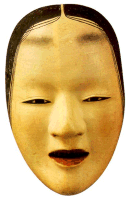No
A classical form of theatre preserved from the 14th cent. Kanami
(1333-84) and his son are attributed as the major developers of this
art form. There is a repertoire of some 240 plays. The principle actors
are masked and as in Kabuki there are no women, men take female parts.
All of the plays have very simplistic plots and the activity I in
a kind of slow-motion. There is much Zen influence and very powerful
symbolism. The stage is traditionally eighteen feet wide and the backdrop
is always plain except for a painted pine tree. Musical accompaniment
comes from three drums and flutes. Kyogen,
are the humorous interludes between plays.
The best place for seeing No theatre is in Kyoto.
|
 |


